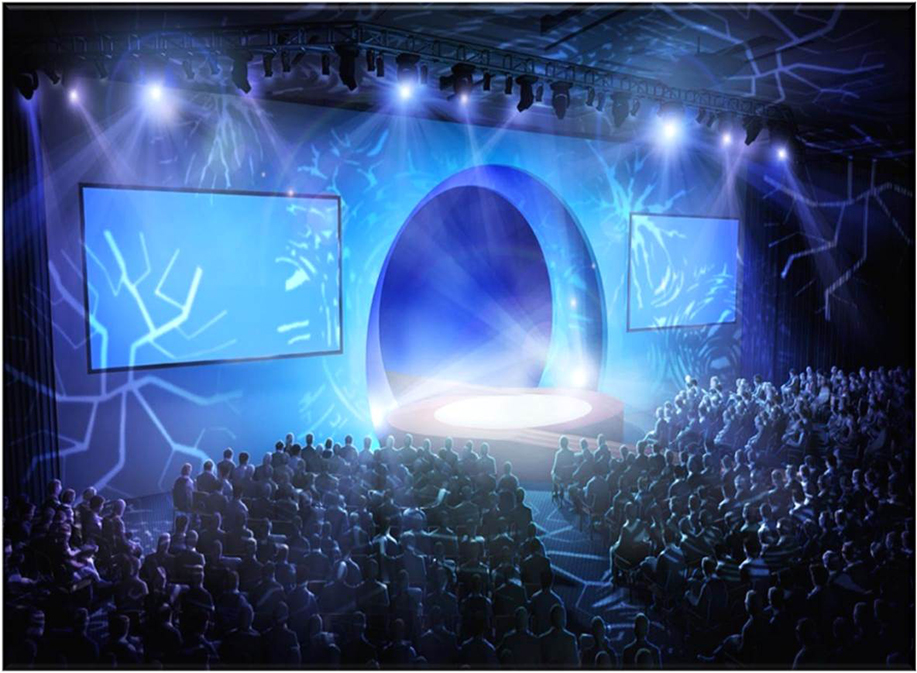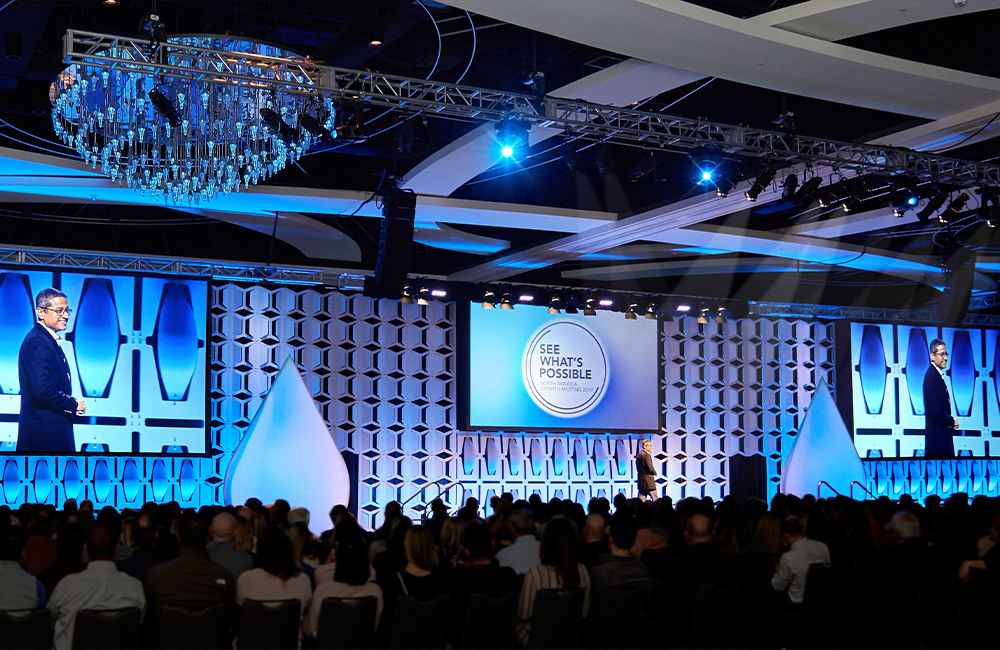Have you ever been in the back row of a general session and seen scores of laptop screens flash back at you? Not with enthusiastic note-taking- but with online shopping carts, muted golf games, and the occasional personality quiz to see which sandwich your zodiac sign would be. At Tallen, we’ve seen it all and have been in the audio-visual industry long enough to know creative AV design is essential to engaging an audience. Let’s explore how our creative department combines scenic design and AV equipment to produce an unforgettable experience.
Rendering Reality
To execute an outstanding event, you must have an accurate understanding of the venue’s capacity. Sometimes this can be difficult because many event spaces provide blueprints of meeting rooms that don’t account for the things that will take up square footage. Therefore important factors such as maximum occupancy are imprecise and hinder planning.
At Tallen, we anticipate and solve this issue ahead of time by providing 3D rendering flythroughs of final designs at the actual venue. These simulations let the clients see exactly what the conference spaces will look like with our staging, scenic design, and AV equipment. Since the rendering replicates the venue, our clients can trust that all elements and seating layouts will work.
Set the Stage With Scenic AV Design
The main point of any industry event or conference is to communicate a message. By collaborating with your marketing team, we can create experiences that reinforce that message without ever saying a word. Below are examples of how we’ve represented key ideas through tangible elements.
Create Immersive Environments
One way AV and scenic staging can engage attendees is by finding immersion opportunities. For example, at an AMEX event in Barcelona, the client wanted to convey the concept of welcoming the new businesses they’d acquired into their corporate family and emphasize inclusivity over assimilation.
With the family theme in mind, we started scenic designs in the foyer, where attendees found a living room lounge area with a rug, sofa, and comfy armchairs gathered around a crackling fireplace. The entrance to the main ballroom was designed to look like the front yard of a house, with a branded roofing structure built over the door, welcome mats, and decorative plants. Inside, the main stage had been set up to look like a backyard stone patio, complete with outdoor furniture, hedges, and trees.
By expanding the scenic design to the venue’s common areas, we reiterated the message of inclusion. Meanwhile, physicalizing the scene allowed the audience to interact with it and process the meaning on a deeper level.
Extend the Stage Using AV Design and Equipment
Another method of immersing the audience is to enhance the viewing experience by extending the stage. In large venues, this is especially important, and we often project real-time IMAG footage onto modular back paneling or overhead delay screens so everyone has the best seat in the house, no matter where they are.
Sometimes the issue is not the size of the room but the dimensions. Take, for instance, an event we produced for Boeing: The room was long and narrow with a low ceiling, resulting in a significant distance between the stage and most of the audience. To compensate for that experiential gap, we rigged LED tiles to ceiling trusses so they formed horizontal columns that started at the stage and hovered over the audience for a skylight effect. Then, we used the tiles to display footage of a Boeing jet flying overhead, enhancing the viewer experience and making the room feel more expansive.

As AV industry veterans, we prioritize sharing the client’s message. At the same time, we appreciate the dramatic payoff of slick audio-visuals. Our challenge and pleasure are finding unexpected ways to use the latter to accomplish the former, as we did for Boeing.
Build Symbolic Structures
A design element that works especially well for product launches is creating symbolic structures. For example, a pharmaceutical company was rolling out a new neurological drug. The point of the event was to celebrate the launch and present the research which proved the medication’s efficacy. For that reason, our creative department built a stage in the shape of the drug’s logo, and our AV technicians rigged jib cameras to focus on the speaker until he gave the verbal cue for the cameras to pull out into an aerial view of the stage. Big reveal moments like these keep the audience interested and attentive.
Symbolic structures also played a role in scenic design at the presentation of a new over-the-counter eyedrop product by a well-known maker of ophthalmic solutions. Take a look at the image above this article’s title. The logo was a blue eyedrop, so we built a life-size replica to scale and placed them on the stage for dimension. The creative team stretched blue spandex fabric over a hollow aluminum frame for a transparent structure. Meanwhile, our av team illuminated the drops by placing floor spotlights behind them. The result was aesthetically pleasing from an audience perspective and provided visual cohesion between the content’s message and stage design.
These examples demonstrate the symbiotic relationship between art and AV technology that is essential in producing events that capture and keep attendee attention. The key is adjusting each approach so it adapts to the other. Whether installing mobile jib cameras to get a full overhead image of the stage or opting for lightweight materials to make lighting pop and striking easier, successful execution depends on an agile partnership between the design and AV teams.
Focus on Cohesive Staging
While we’re not conscious of it, set design colors in the narrative of any movie or show we watch. An iconic illustration of this is Patrick Bateman’s apartment in American Psycho. Each design element reflected something about his character. It was monochromatic, pretentious, and clinical to indicate Bateman’s hollow facade while hinting at his true self in the furniture’s sharp metal and glass angles. Bateman’s bachelor pad indirectly exposes the central plot before there’s even dialogue.
Similarly (but in a much less creepy way), your event’s stage should impart the content’s primary themes and subject matter. The colors, shapes, graphics, and audio-visuals can be individually unique while working in concert.
For instance, at the neurological drug launch mentioned earlier, we needed a fixed scenic design to shoulder the event’s essence since the aerial stage unveiling would be relatively brief. So, our lighting designer projected images of neural synapses on the stage’s custom background wall to evoke the drug’s purpose and add sustained visual interest.

At a USAA event celebrating Veterans Day, Tallen’s creative team supported the patriotic theme by adding modular back paneling lit up with red and blue stripe graphics and red draping at the front of the stage. To add structure, we built trusses around the center stage entrance and mounted square tiles, which we attached sideways for a diamond shape. Each diamond displayed stars overlaid with a branded image.
Produce a Memorable Event With Tallen
Seeing the proof of concept via 3D flyovers helps Tallen clients feel confident in the success of their event. As the head of our creative department, Trench Brady, often says, “An image is a contract.” And at Tallen, we honor that trust with a collaborative spirit and distinctive AV design strategies that allow your attendees to appreciate the content on a deeper level. Visit our website to learn more about Tallen’s creative capabilities and how we produce engaging events.
